Report of the Smelling Committee
A poet's nose reports on artist Gudrun Lock's Shoreham Yards Smelling Committee
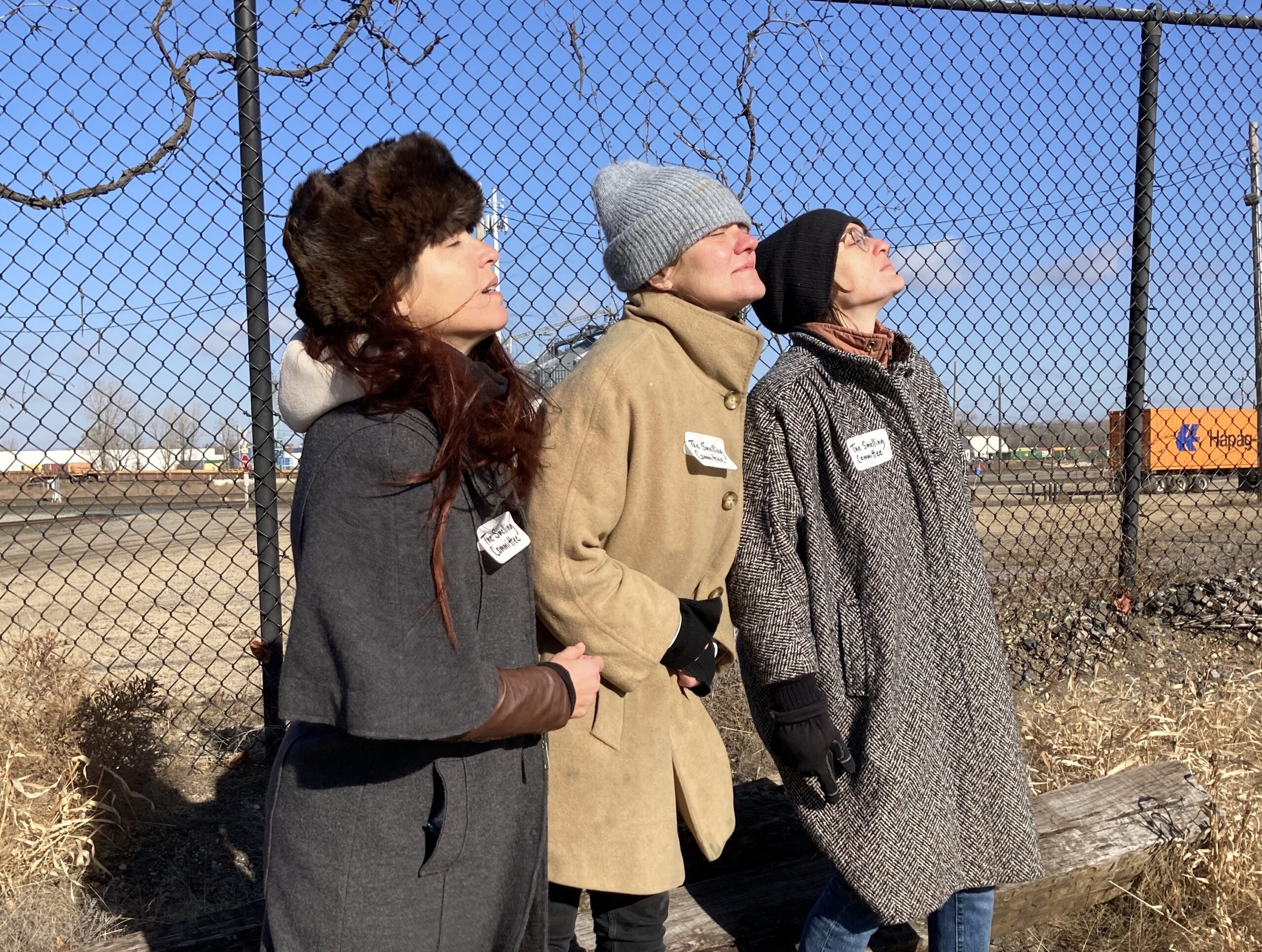
REPORT OF THE SMELLING COMMITTEE
TO: YOU, DEAR READER
RE: THE ODIFEROUS BUFFERS OF SHOREHAM YARDS
Date of Report: 26 FEBRUARY 2025
Report Author: Elisabeth Workman
Purpose of the Report
On June 6, 2023, Gudrun Lock, artist and founder of the Shoreham Repository, sent packets to an undisclosed group of Minneapolis residents, inviting them to participate in the Shoreham Yards Smelling Committee, i.e. to “accumulate temporal, sensorial, and ephemeral data from the perimeter of Shoreham Yards.” The invitation suggested the tasks of the Smelling Committee could be performed alone or in groups and offered a list of dates for optional group outings in June and July of 2023. The packets included a hand-drawn map of Shoreham Yards (the 230-acre intermodal trainyard situated in a residential area of Northeast Minneapolis), a Smelling Request Form (a multi-page observational survey to guide Smelling Committee members in their assessment of the perimeter of Shoreham Yards), a Smelling Committee badge, and a SASE in which findings could be returned. Also enclosed was a sealed envelope labeled “current and historic details pertinent to the Yards.” Opening this envelope–whether before or after performing the Smelling Committee investigation–was optional. To participate in the Smelling Committee at all was optional.
This report serves to document the activity of the Shoreham Yards Smelling Committee, its context, scope of work, and a sampling of the findings of those who participated in its labor.

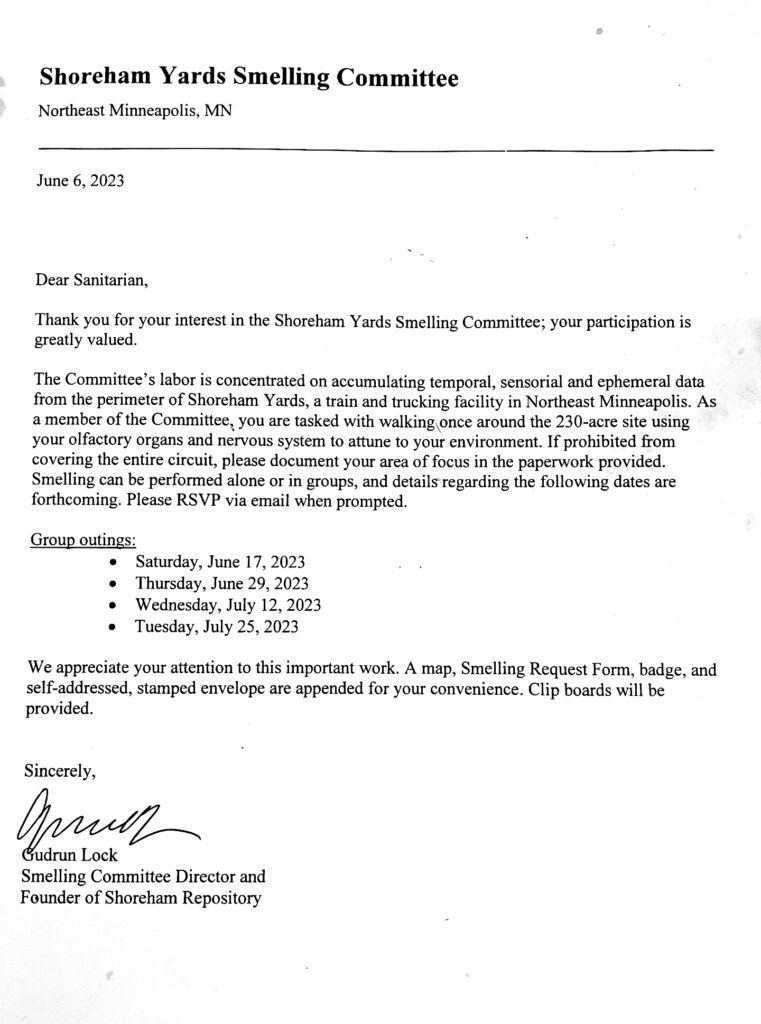
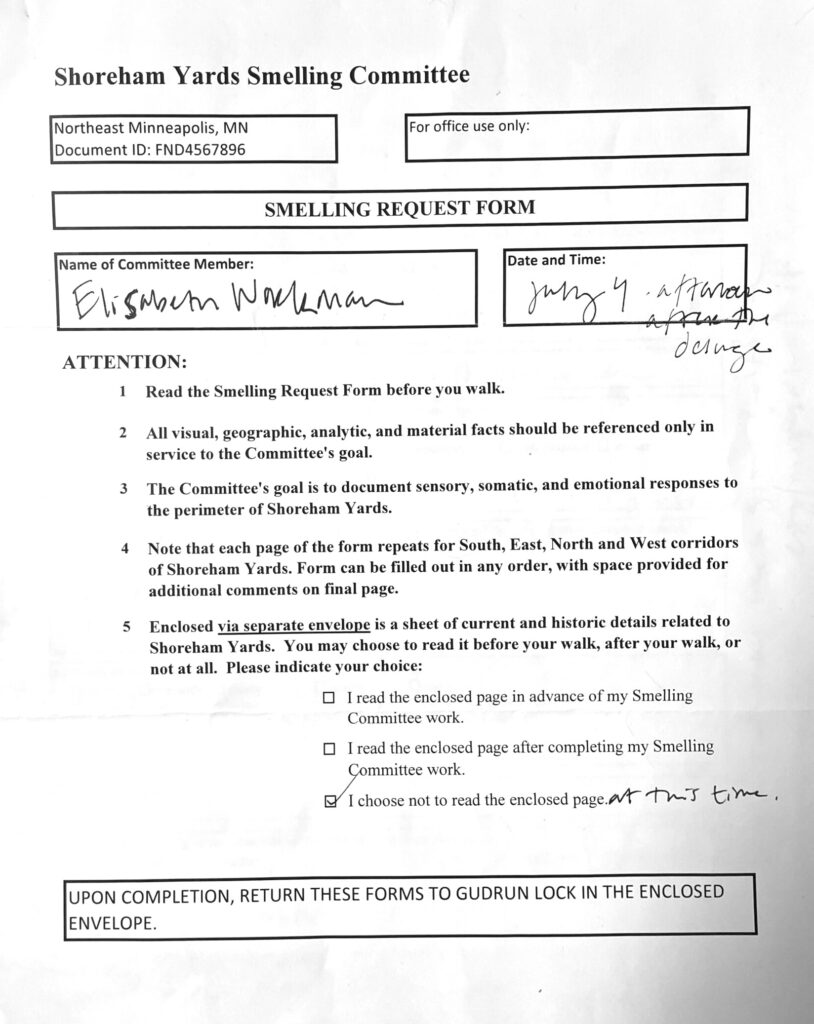
Context
1. The existence of “smelling committees”–groups of experts and concerned residents appointed by city officials–can be traced back to America’s emergent, burgeoning cities, which were, by many accounts, centers of commerce! civics! extreme wealth! squalor! corruption! culture!! crime!!! & stench!!!!
2. Smelling committees emerged circa the Civil War, the waning of miasma theory, the waxing of germ theory, and the increasing toxicities of the Industrial Revolution.
3. The committees were tasked to sniff out the sources of the malodorous breezes, strange fumes, and enduring noxiousness that inspired city residents to complain.1
4. “Night air” redirects here.2
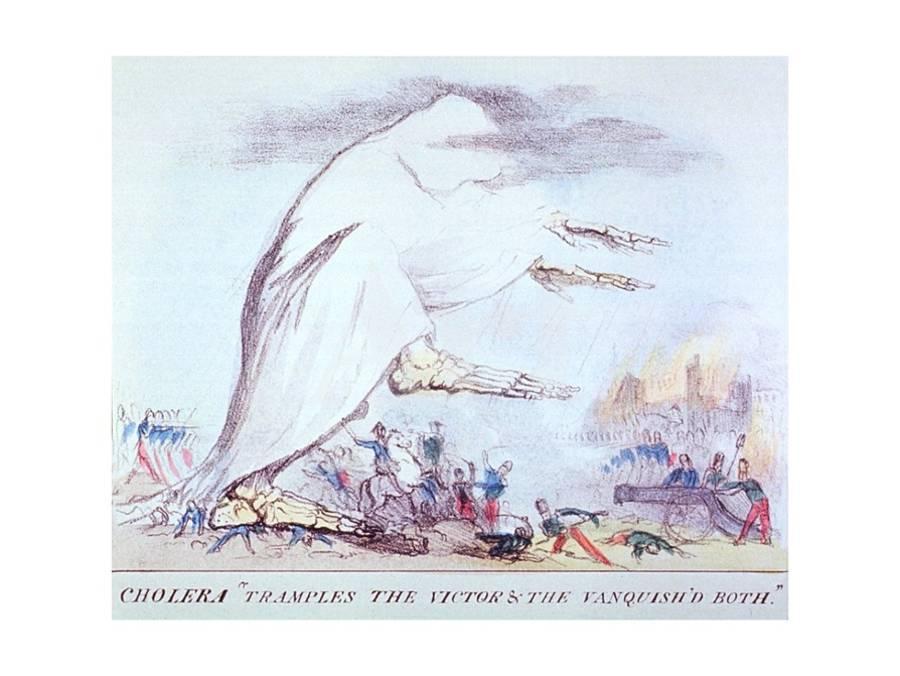
5. It was believed miasma–a form of “bad air”, aka “night air”–emanated from rotting organic matter and spread plagues and epidemics (e.g. cholera, chlamydia, the Black Death).

6. During a different plague, the Covid pandemic, Gudrun Lock, who lived two blocks away from Shoreham Yards, developed an ineluctable hypersensitivity to her environs. The blue light from computer and phone screens, the kinetics of scrolling, the vibrations of digital sounds–i.e. the banal and ubiquitous aspects of contemporary American life–became unbearable. During this time, she would often wake up at 3 in the morning, hear strange noises coming from the trainyard, and notice “noxious smells in the morning.”
7. In his 2024 description of Covid called Plague Bill, Simon Critchley writes: “It was as if something archaic–elemental, primeval, and long dead–awakened in the plague.”3
8. “Because of this nervous system problem,” Ms. Lock remarked, “I felt like I could feel the world like a turtle or a frog or what it might be like to be a coyote. I could feel every rumble, every exhaust pipe, everything. . . . it felt like another realm.”
9. We feel drawn to the unknowable under such conditions. Plague Bill: “Some of them began to wonder about the nature of these archaic feelings and how they might understand the mysticism that had revived, like some unbidden ghost.”4
10. Miasma: 1) (An) infectious or noxious vapour, esp. from putrescent organic matter, which pollutes the atmosphere. 2) fig. A polluting, oppressive, or foreboding atmosphere; a polluting or oppressive influence.5
11.
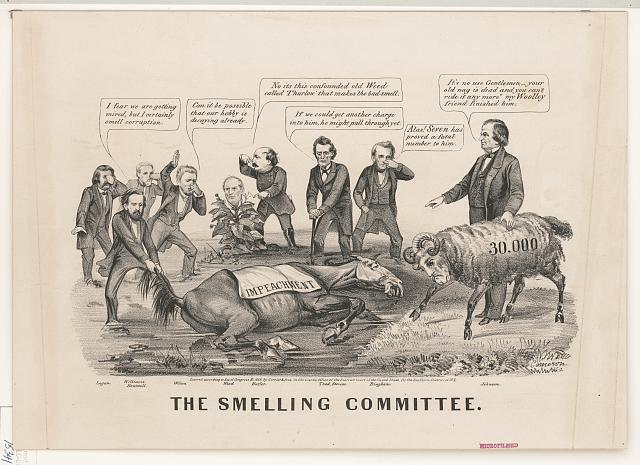
Here a smelling committee detects the stench of an impeachment (in this case, of Andrew Jackson) gone wrong.
12. Miasma (μίασμα):–“stain,” “defilement,” or “the stain of guilt” in Greek. It is usually translated as “pollution” in English. In Greek myths like Oedipus the King, it occurs as a kind of physical, psychological, and spiritual pollution brought about–according to the Oracle of Delphi–by unatoned-for crimes.
13. In which smelling situates us closer to the visceral domain of animal narrative, and bad smells–taboo.
14. In A Natural History of the Senses, Diane Ackerman observes: “Smell is the mute sense, the one without words. Lacking a vocabulary, we are left tongue-tied, groping for words.”6
15. In which smell, in its silences, beckons ineffability.
16. That we might have to call upon other senses and feelings when tasked with smelling through the poetic powers of synesthesia.
17. In which smell is mystery and bridge.
18. In which inherently we know (and have known) smell is a bridge to memory.
19. In which time, beyond our collective hallucination of linear progression, might actually be curling around itself. And in that spiral, smell might serve as a bridge to the future or an otherwise otherwhere.
20. I.e. The osmic is cosmic.
Scope of Work

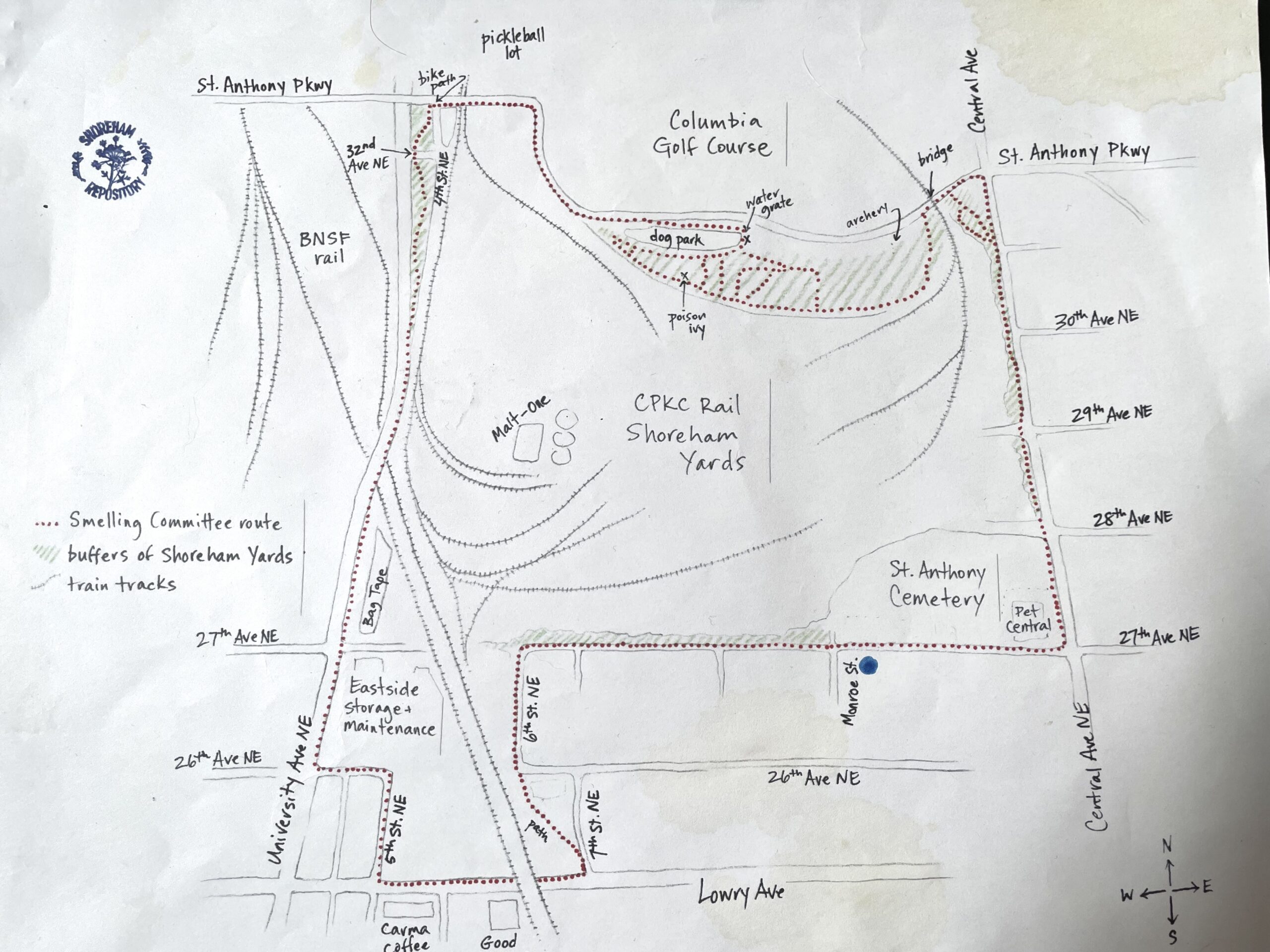
- Methodology: The “SMELLING REQUEST FORM” Committee members received is a 10-page questionnaire, guiding participants around Shoreham Yards, with the following instructions:
- Read the Smelling Request Form before you walk.
- All visual, graphic, analytic, and material facts should be referenced only in service to the Committee’s goal.
- The Committee’s goal is to document sensory, somatic, and emotional responses to the perimeter of Shoreham Yards.
- Note that each page of the form repeats for South, East, North and West corridors of Shoreham Yards. Form can be filled out in any order, with space provided for additional comments on final page.
- Enclosed via separate [sealed] envelope is a sheet of current and historic details related to Shoreham Yards.
- Outcome: Created by Ms. Lock, the questions–which engage multiple senses and feelings–orient participants toward recording their somatic experience of the buffers in precise words and phrases.
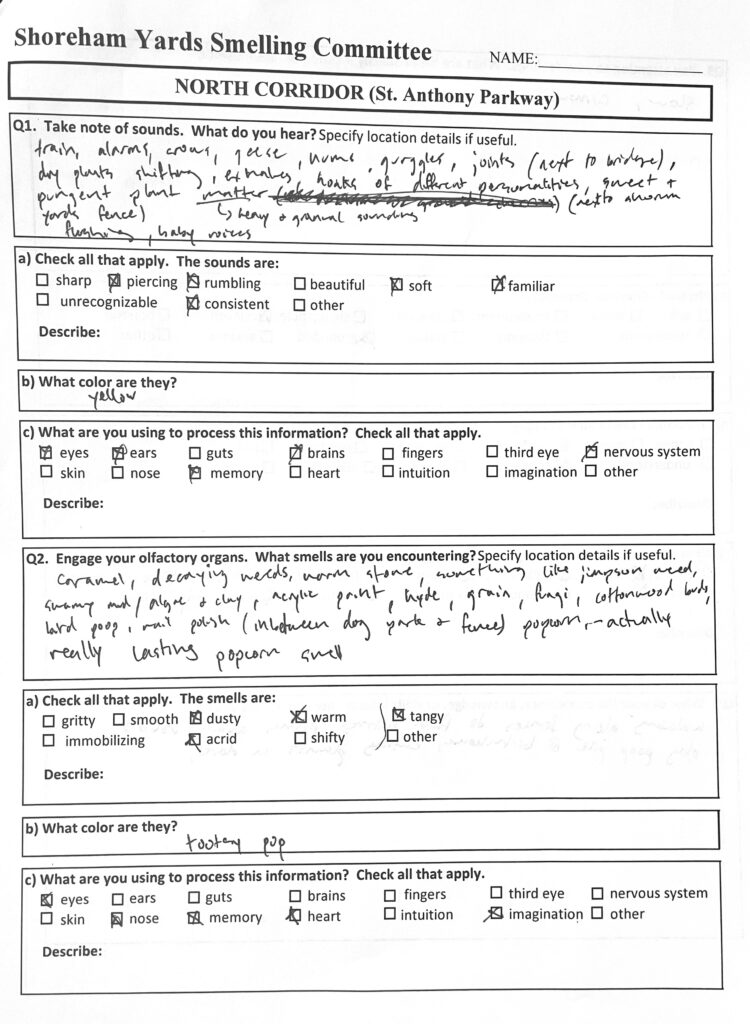
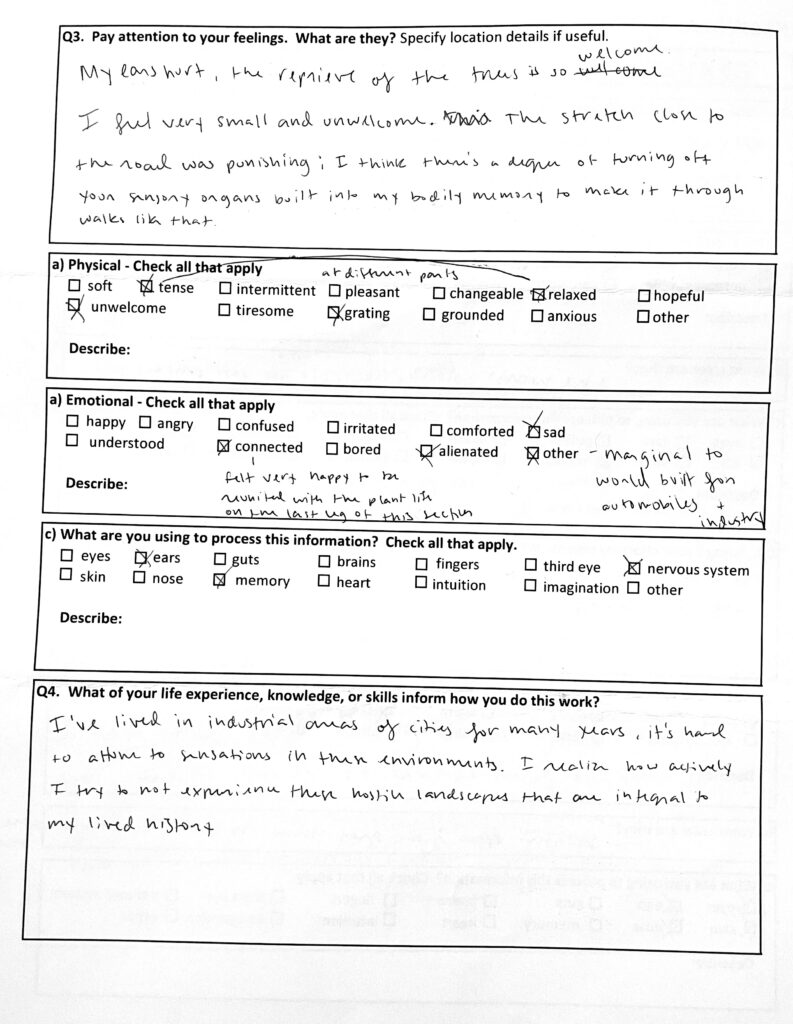
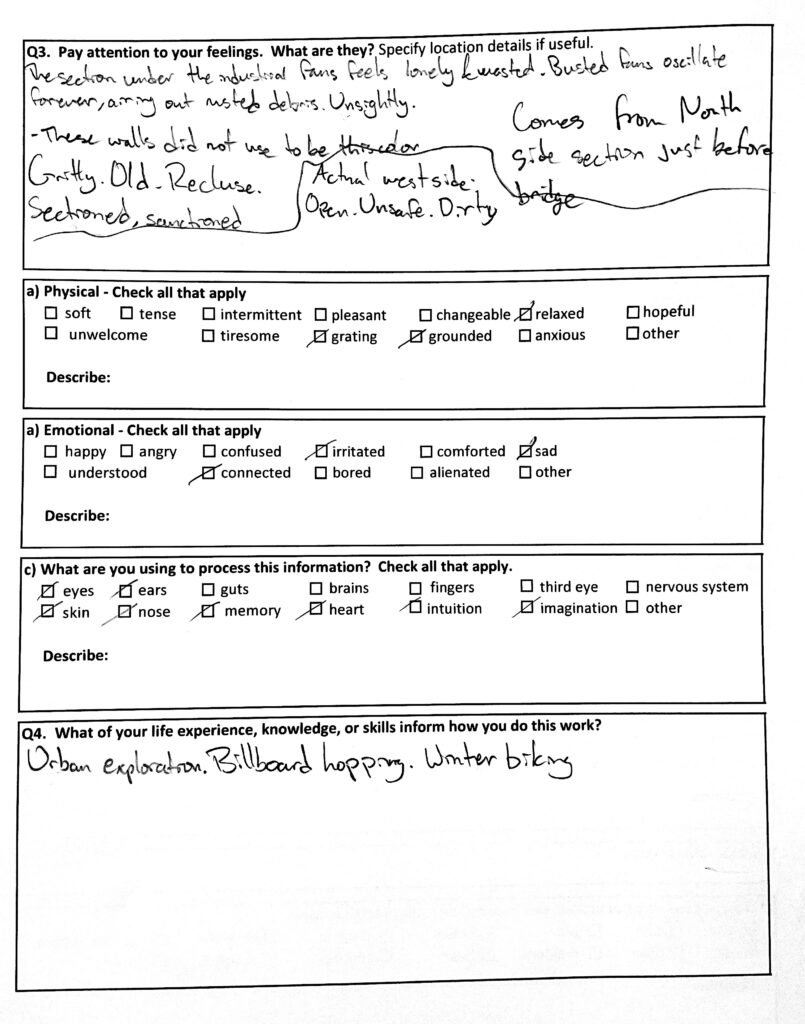
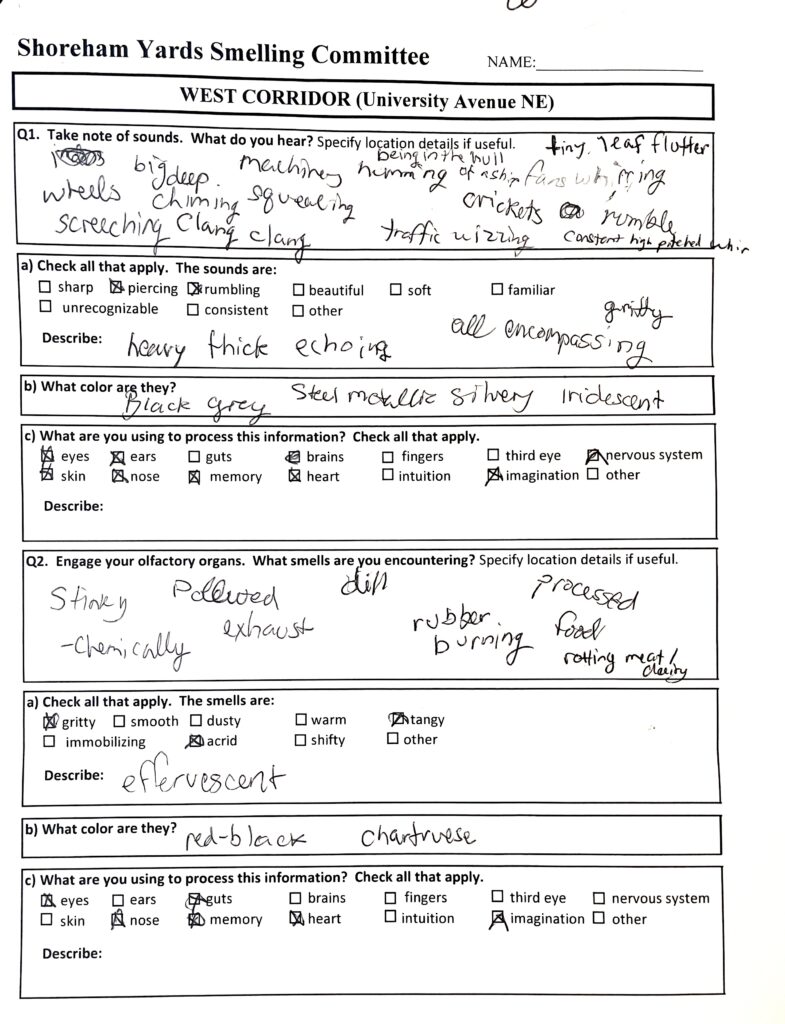

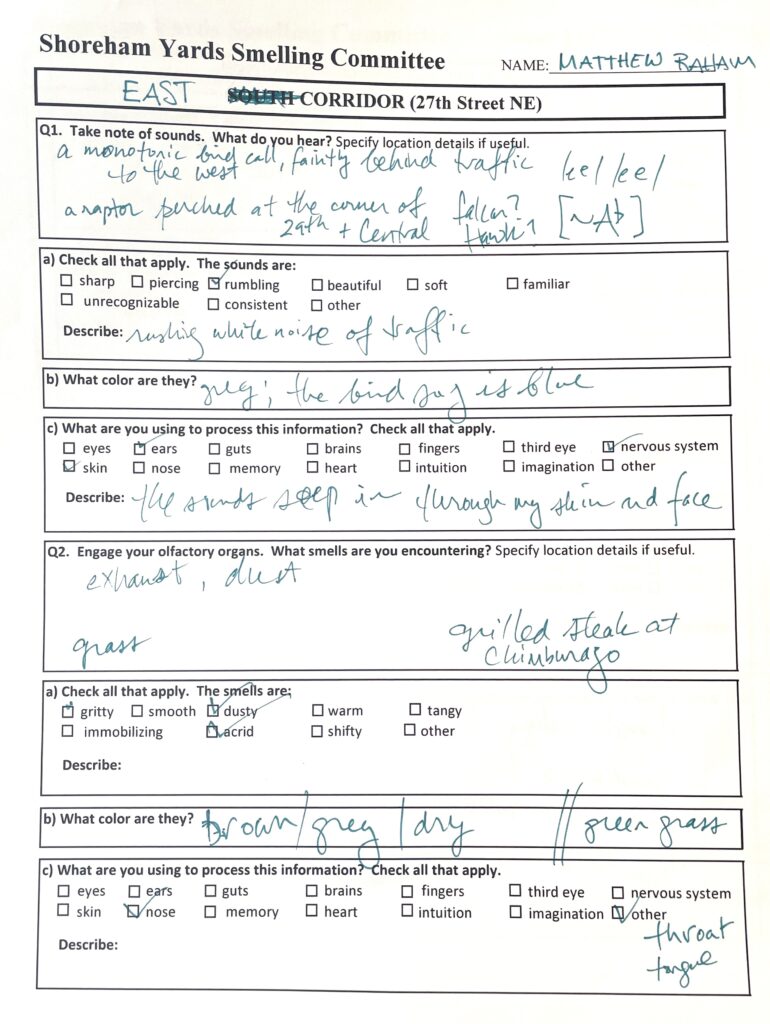
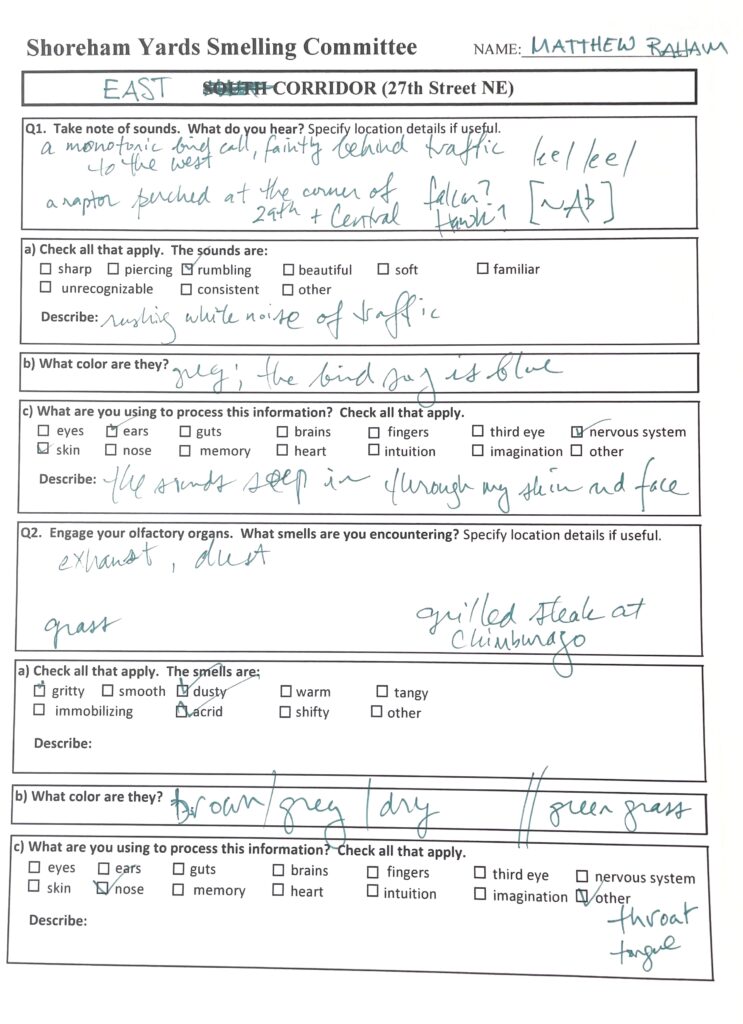
Findings Smellings
The following index of odors distills the sensation of smell (scentsation?) from completed Committee member surveys and presents the smell-impressions with attributions culled, cut up, and recombined from participant observations. The objective is to offer a synesthetic, metabolized portrait of the odors of Shoreham Yards with no attachment to source, comprehensiveness, or reason, but more in a spirit of occult collective attunement. This index straddles the formality of the Committee’s administrative tools with the messy, subjective, emotional experience of its tasks. Bringing a poet’s nose to this report, I’m interested in the possibilities of affective correlatives as thresholds that open up to the otherwhere and otherwise the survey inspires.
Acrylic paint: zeal’s drama warm-up
Asphalt: meow steel honk plane my first boyfriend, tired
Basswood: when maze is shimmer
Burning plastic: changeable pain sticky America
Car air freshener: houses are silent and closed up
Caramel: soft trains
Cardamom: understood, years after a beautiful fire
Cedar: expansive waft system
Cereal: other children do fine
Charcoal: eyes, wood, alienated blue
Chemical(ish): these walls did not used to be this color
Chimborazo: flour water warmth
Cigarette smoke: hungry ghost welcome
City bus: electric, comforted, strung out
Cologne from a passing car: heavy built bird
Cottonwood buds: this connected wonder
Creeping Charlie: a monotonic bird call
Creosote: busted fans oscillate forever
Diesel: huffs icy yearnings
Dog poop: rotting woo
Donuts: sweet creeping cliques
Dead fish: I smell my DEET, which also deters me. Briefly, 6th street and 26th avenue, Lowry and 4th
Earth: green imagination = blue sounds = weird beauty = alarm
Exhaust: mechanical anxiety
Fall leaves: peaceful, unease in the background
Fennel: memory of dew, silver
Fungi: leaf ghost children
Gasoline: clang from metallic gathering calls
Grass: unknowing grasshoppers, your milk
Grass clippings: untangle my fingers
Hot dogs: wee woo wee woo
Laundry dryer sheets: fume fans very thick
Lavender: cyclists flower the nostalgia
Marijuana: plants time jumping, soft heart
Milkweed: tender curiosity bursts
Mold: wander recluse like melancholy plants
Mulch: Raptor, I rot.
Nail polish: bright urge the industrial slick
Old sweat: orange golf skin
Petrichor: transient below memory
Pine: the bird song is blue
Popcorn: rabbit spots tweeting
Perfume: dusk being memory
Rancid oil: acrid ennui
Rotten meat: hot vermic summer
Rubber: crotch rocket unease
Snow coming: being in the null
Something burning: rushing falcon guts
Something musty: dump malt
Something vegetal: lush rustles
Sour milk: can’t white eyes and weight leaves
Sweet grass: amplified prairie skin
Trees: birch not thunderstorm
Wet sand: underbelly intuition
Wormwood: Toulouse hands
Yarrow: boundary the rote
What can’t be captured exactly–and how this report is inherently underwritten by failure–is what happens when we are invited to stop and smell the “roses,” i.e. to slow down and experience a place, any place, in somatic, emotional terms, feelingness and senses activated. An alternative logic begins to emerge and a fluidity and strangeness that the distracted speed and conclusivity of everyday life can’t know. Another way of being is not a far off thing, but right here, even the Superfunded, liminal here that most often goes unnoticed.
A compilation of complete findings, untampered with, can be found here.